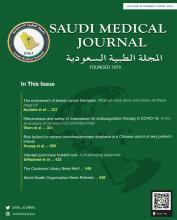Review Article
The evolvement of breast cancer therapies. What we have done and where all these head off
Nurlaila & Pambudi investigate breast cancer (BC). The Her-2+/PR+/ER+ BC can benefit from the mainstays of anticancer therapy and immunotherapy and overall have a better prognosis. Triple-negative BC, due to the concomitant absence of Her-2/PR/ER receptors, is more challenging and necessitates different strategies. It has been learned that the mainstay anti-BC therapies were initially designed to demolish as many cancer cells as they possibly could. However, the number of reports on the adverse effects of these mainstay therapies has recently been increasing. It underpins efforts to reshape such therapies into much better and safer forms over time. Moreover, some current findings on the molecular markers, which are target-potential, have also shifted the paradigm from radical-to-local-yet-precise-approach to meet the need for a therapy platform that is less cytotoxic to normal cells yet efficiently kills cancer cells.
Immune checkpoint-based immunotherapy.
see page 331
Systematic Review
Effectiveness and safety of rivaroxaban for anticoagulation therapy in COVID-19. A meta-analysis of randomized controlled trials
Shen et al evaluate the effectiveness and safety of rivaroxaban anticoagulation in COVID-19 patients. PubMed, Embase, Cochrane Library electronic databases, and ClinicalTrials.gov are searched to identify all relevant randomized controlled trial studies. A total of 6 randomized controlled trials, which included a total of 3323 patients, are considered for evaluation. Overall, short-term all-cause mortality and hospitalization rates are not significantly different between the rivaroxaban and control groups. Thrombotic events are significantly reduced in the rivaroxaban prophylaxis group compared to the placebo control group. However, the reduction in thrombotic events is not significantly different between rivaroxaban therapy and heparin or low-molecular-weight heparin (LMWH). Rivaroxaban prophylaxis and the therapeutic dose may be associated with a higher rate of overall bleeding rate, but major bleeding rates did not differ substantially. They concluded that rivaroxaban may reduce thrombotic events in COVID-19 patients, but it does not appear to have an advantage over heparin or LMWH, and it may increase the risk of bleeding.
Risk of bias summary of included studies.
see page 341
Original Article
Risk factors for severe bronchopulmonary dysplasia in a Chinese cohort of very preterm infants
Huang et al examine the risk factors for severe bronchopulmonary dysplasia (BPD) in a cohort of very preterm infants (VPIs) in China, as BPD is common among VPIs and associated with a high mortality rate. The cohort is stratified into different BPD severity groups based on their fraction of inspired oxygen requirement at a modified GA of 36 weeks or post discharge. Risk factors are identified using logistic regression analysis. A significant inverse correlation is revealed between BPD severity and both GA and BW (p<0.001). They concluded that their study not only reaffirmed the established risk factors of low GA and BW for sBPD in VPIs, but also identified additional, potentially modifiable risk factors. Further research is warranted to explore whether intervention in these modifiable factors might reduce the risk of sBPD.
Histogram of bronchopulmonary dysplasia incidence according to severity by weeks of gestational age at birth.
see page 369
Case Report
Infected pulmonary hydatid cyst. A challenging diagnosis
AlRashed & AlShahrani present a 7-year-old found with a superimposed infected pulmonary hydatid cyst that was initially misdiagnosed as complicated pneumonia. Their case underscores the challenges of diagnosing and managing echinococcosis, emphasizes the need for a high index of suspicion, and describes the disease’s ability to mimic other clinical entities.
see page 433
- Copyright: © Saudi Medical Journal
This is an Open Access journal and articles published are distributed under the terms of the Creative Commons Attribution-NonCommercial License (CC BY-NC). Readers may copy, distribute, and display the work for non-commercial purposes with the proper citation of the original work.










